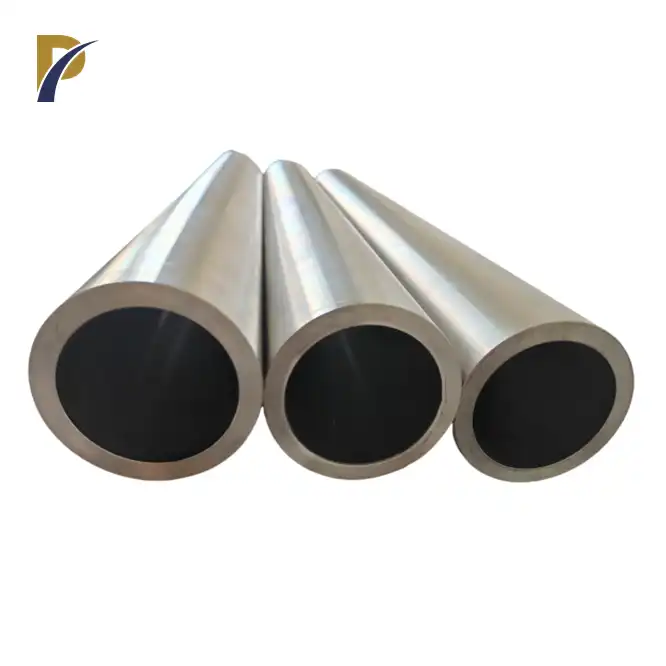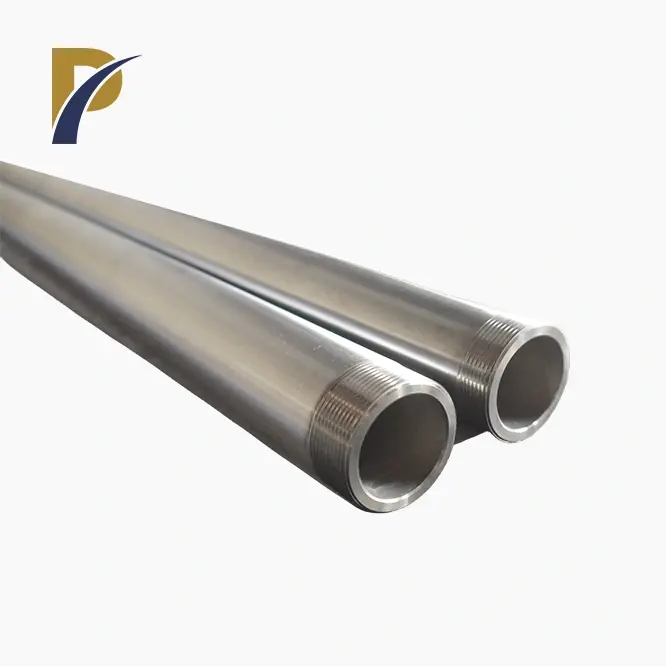A molybdenum tube target is a critical component used in various thin film deposition processes, particularly in the manufacturing of electronic devices and advanced materials. This cylindrical structure, composed of high-purity molybdenum, serves as a source material for sputtering applications. When bombarded with high-energy particles, the molybdenum atoms are ejected from the target surface and deposited onto a substrate, forming thin films with specific properties. The tubular design of these targets allows for efficient cooling and uniform material distribution, making them ideal for large-scale production and applications requiring precise control over film thickness and composition.
Properties and Characteristics of Molybdenum Tube Targets
Chemical Composition and Purity Levels
Molybdenum tube targets are renowned for their exceptional purity, often exceeding 99.95%. This high-purity molybdenum tube target composition is crucial for ensuring the quality and performance of the resulting thin films. The chemical makeup of these targets is carefully controlled to minimize impurities that could compromise the integrity of the deposited layers. Trace elements are meticulously monitored and kept below specified thresholds to maintain the target's performance and longevity.
Physical Attributes and Dimensions
The physical characteristics of molybdenum tube targets are tailored to meet the specific requirements of various sputtering systems. These targets typically feature a cylindrical shape with precise dimensions, including outer diameter, inner diameter, and length. The wall thickness of the tube is carefully engineered to balance material utilization and structural integrity. Surface finish is another critical aspect, with targets often polished to a mirror-like smoothness to ensure uniform sputtering and minimize particulate generation during the deposition process.
Thermal and Electrical Properties
Molybdenum's inherent properties make it an excellent choice for sputtering applications. Its high melting point (2623°C) allows for stable operation under intense heat generated during the sputtering process. The material's good thermal conductivity facilitates efficient heat dissipation, preventing localized overheating and ensuring uniform target erosion. Electrically, molybdenum tube targets offer low resistivity, enabling consistent power delivery and plasma stability during sputtering. These thermal and electrical characteristics contribute to the target's overall performance and reliability in thin film deposition systems.
Manufacturing Processes for Molybdenum Tube Targets
Raw Material Selection and Preparation
The production of high-purity molybdenum tube targets begins with the careful selection of raw materials. Ultra-pure molybdenum powder or ingots serve as the starting point, undergoing rigorous quality control to ensure minimal contamination. The raw material is then processed through various refining techniques, such as electron beam melting or zone refining, to further enhance its purity. This meticulous preparation stage is crucial for achieving the high-purity molybdenum tube targets required for advanced sputtering applications.
Forming and Shaping Techniques
Several advanced manufacturing methods are employed to transform the refined molybdenum into tubular targets. One common approach involves powder metallurgy, where high-purity molybdenum powder is compacted and sintered to form a dense, uniform structure. Alternatively, molybdenum ingots may be subjected to hot extrusion or centrifugal casting to create the tubular form. These processes are carefully controlled to ensure consistent density, grain structure, and dimensional accuracy throughout the target. Post-forming treatments, such as hot isostatic pressing (HIP), may be applied to further enhance the target's density and homogeneity.
 |
 |
Surface Treatment and Quality Control
The final stages of molybdenum tube target production involve precise machining and surface treatment. Computer numerical control (CNC) machining is utilized to achieve the exact dimensions and tolerances required for specific sputtering systems. Surface finishing techniques, including grinding, lapping, and polishing, are applied to create the ultra-smooth surface necessary for optimal sputtering performance. Rigorous quality control measures, such as non-destructive testing, chemical analysis, and surface inspection, are implemented throughout the manufacturing process to ensure each target meets the stringent specifications demanded by the semiconductor and electronics industries.
Applications and Advantages of Molybdenum Tube Targets
Semiconductor and Electronics Industry
Molybdenum tube targets play a pivotal role in the semiconductor and electronics sector, particularly in the fabrication of advanced integrated circuits and display technologies. In semiconductor manufacturing, these targets are used to deposit thin films for interconnects, diffusion barriers, and gate electrodes. The high-purity molybdenum tube targets ensure minimal contamination, critical for maintaining device performance and reliability. In the display industry, molybdenum films deposited from tube targets serve as electrodes in flat panel displays, contributing to improved conductivity and optical properties.
Solar Cell Fabrication
The renewable energy sector, specifically solar cell production, benefits significantly from molybdenum tube targets. These targets are used to deposit back contacts in thin-film solar cells, such as copper indium gallium selenide (CIGS) photovoltaics. The molybdenum layer acts as a crucial component, providing excellent adhesion to the substrate, low electrical resistance, and a barrier against impurity diffusion. The uniformity and purity of the deposited molybdenum film, enabled by high-quality tube targets, directly impact the efficiency and longevity of solar cells.
Advantages Over Other Target Configurations
Molybdenum tube targets offer several advantages compared to planar or rotary targets. Their cylindrical geometry allows for more efficient cooling, enabling higher power densities and increased deposition rates. The tubular design also promotes more uniform target erosion, leading to improved material utilization and extended target lifespan. Additionally, the ability to rotate the target during sputtering enhances film uniformity across large substrate areas, a critical factor in large-scale production environments. These benefits, coupled with molybdenum's inherent properties, make tube targets an optimal choice for demanding thin film applications requiring precision, consistency, and high throughput.
Conclusion
Molybdenum tube targets represent a cornerstone technology in the realm of thin film deposition, offering unparalleled performance in various high-tech manufacturing processes. Their unique combination of material properties, precision engineering, and versatile applications makes them indispensable in industries ranging from semiconductors to renewable energy. As demand for advanced electronic devices and efficient solar cells continues to grow, the role of high-purity molybdenum tube targets in enabling these technologies becomes increasingly significant, driving ongoing innovation in target design and manufacturing techniques.
Contact Us
For more information about our high-quality molybdenum tube targets and other non-ferrous metal products, please contact Shaanxi Peakrise Metal Co., Ltd. at info@peakrisemetal.com. Our team of experts is ready to assist you in finding the perfect solution for your thin film deposition needs.
References
Johnson, M. K. (2021). Advanced Materials for Thin Film Deposition: A Comprehensive Guide. Materials Science Publishing.
Zhang, L., & Chen, X. (2020). Sputtering Technology in Semiconductor Manufacturing. Journal of Applied Physics, 128(5), 051101.
Tanaka, H., et al. (2019). High-Purity Molybdenum Targets for Next-Generation Electronics. Thin Solid Films, 670, 31-37.
Ramirez, A. G. (2018). Molybdenum in Thin Film Solar Cells: Current Status and Future Prospects. Solar Energy Materials and Solar Cells, 174, 147-155.
Liu, Y., & Wang, S. (2022). Advances in Tubular Sputtering Target Technology. Vacuum, 196, 110721.
Brown, D. R., et al. (2020). Comparative Analysis of Planar, Rotary, and Tubular Sputtering Targets. Surface and Coatings Technology, 385, 125433.
